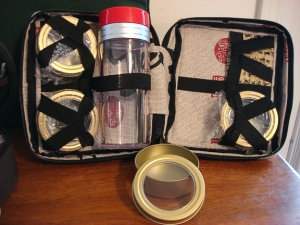Facebook can be so much fun. And so broadening: You get to “meet” all kinds of people who are involved in all kinds of businesses, hobbies, and activities.
Because of my own interest in crafting with tea — tea-dyed textiles and tea-bead jewelry via CrafTea Designs — I’m always delighted to find fellow tea lovers and crafters whose products feature genuine tea.
One such person is Kim Williamon, proprietor of The Gilded Lily Soaps & Scents, who handcrafts luscious soaps that incorporate tea in their chemistry and their design. I recently had the opportunity to ask Kim a few questions about her business, her craft, and her teas.
How did you get started making soap?
I’m very lucky to have my 92-years young grandmother still with me today. She was a big part of my life growing up. Raised on a large sugar cane farm in South Georgia with her mother and grandmother, she learned to make soap at an early age, along with many other farm crafts. I had the great pleasure of watching her make soap in my youth, and my love for the craft grew.
When did you start adding tea to your soaps?
I started adding teas and tisanes to my soaps in the early 1990s, inspired by my husband: He has very dry, sensitive skin, and is prone to seasonal breakouts. After many trips to our family doctor for creams and shots, which provided no help, I began to research the health benefits of tea and herbs.
What are some of the benefits of adding tea to soap?
The benefits are numerous! Skin is the largest organ in the body, and absorbs everything we put into it or onto it. Tea — especially green tea — is rich in antioxidants and various minerals which help rejuvenate skin cells and heal wounds, and in the treatment of skin conditions such as psoriasis and rosacea. Caffeine helps tighten the skin. Polyphenols aid in increasing skin’s elasticity, reducing the appearance of fine lines and wrinkles, and also act as an anti-inflammatory for sensitive skin. (This is not intended as medical advice; for specific maladies please consult a medical practitioner.)
Do you make any products other than soap? Do they also incorporate tea?
Currently I’m working on liquid soap and body “butter” formulated with tea. These will be added in time for the summer season.
What kinds of teas do you use in your products?
I use only organically-grown whole-leaf loose-leaf teas: whites, greens, oolongs, and blacks. For soaping I grind the dry leaves myself; I’m not a fan of teabags or pre-packaged teas.
How do you decide which teas to use for specific soaps?
I choose teas for their particular benefits to a skin type: dry, oily, sensitive, etc. And I also create seasonal and holiday soaps with the scents I add.
How can customers find and buy your products?
At the moment I’m still working on a website and hope to have it up and running soon. Meanwhile, anyone interested in beautiful soaps made with tea can find The Gilded Lily: Soaps & Scents on Facebook; if you “Like” us and add us to your newsfeed you’ll be notified of new products and when our website goes online. Send me a Direct Message (DM) to order. For product photos and pricing, visit our Pinterest page.
What are your favourite teas to drink?
In my cup I like oolongs (Formosa Spring Dragon, Ti Guan Yin, and Se Chung), Japan green teas (Gyokuro kenjyo, Ho-ji Chi Kamakura, and Gen-mai Cha), and white teas (Moonlight and Yin Zhen Bai Hao Downy White).
Follow TeaGuide on Twitter @TeaGuide1
Friend TeaGuide on Facebook
Contact us about reviewing your tea or tea-related product, or to be interviewed.
All content Copyright 2013 JP Badarau; all rights reserved.
# # # #






